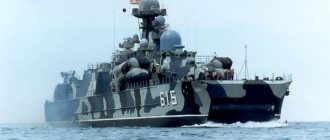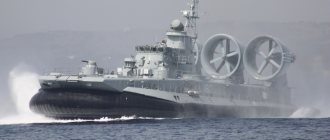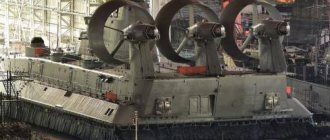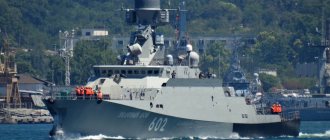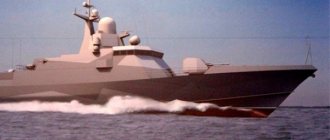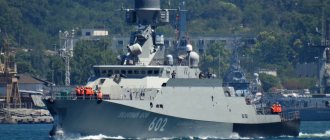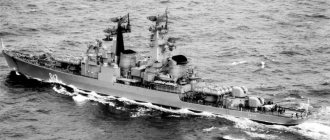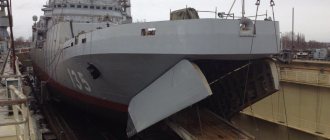Rocket hovercraft of the "Sivuch" type, pr. 1239
The first missile hovercraft, Project 1239, was the RKVP "Bora", laid down in 1984 at a plant in Zelenodolsk near Kazan, delivered to the Navy in 1989 and, after trial operation, in 1997 it became part of the permanent readiness forces of the Black Sea Fleet. Soon after the firstborn, the second ship of this series, Samum, was laid down. The small hovercraft with skegs, Project 1239 (code "Sivuch") was designed between 1974 and 1987 at the Almaz Central Marine Design Bureau under the leadership of L.V. Elsky. The ship is designed to strike enemy surface ships and is assigned to the second rank.
RKVP was created as a development of small missile ships of projects 1234 and 1234.1. The experience of using MRKs in combat service in the Mediterranean has shown that ships of this size and classical formations are limited in the placement of weapons. Catamaran pr.1239 has a large deck, which allows solving this problem, more comfortable conditions for using weapons and accommodating the crew. In addition, it has high seaworthiness. When creating the RKVP, the experience of the Almaz Central Marine Design Bureau and the shipbuilding industry, acquired during the construction of air-cushion landing ships such as Dzheiran, Zubr, etc., was also widely used.
RKVP has unique shipbuilding qualities. First of all, these include the transformability of the hydrodynamic platform and versatility - 36 options for using the propulsion system. On the one hand, the ship is a catamaran with a speed range of up to 20 knots, on the other, it is a high-speed hovercraft with a maximum speed of over 50 knots.
The ship has a hull in the form of a sharp-cheeked catamaran with inflatable flexible fences in the bow and stern to hold the air cushion. The hull and superstructures are made of light aluminum-magnesium alloys. The power plant includes two gas turbine engines, which, through an angular gear transmission, drive two tandem propellers on columns that rise from the water when moving under the diesel engines. Each of the two diesel engines drives its own propeller. Two gas turbine engines with a power of 60 thousand hp each. allow you to reach a speed of up to 55 knots even with a wave height of 2 m, and with 5 points (wave 3.5 m) - more than 40 knots. High speed allows the ship to avoid being captured by homing missiles; for the same reason, a torpedo does not have time to catch up with it. To form an air cushion, two autonomous diesel injection units are used. Seaworthiness - up to 8 points. Having two separate propulsion systems for cruising and full speed, capable of working separately and together, the ship can move in three main modes (catamaran, KVP-1 and KVP-2), which provides an almost 100% guarantee of progress in any situation. Thus, over all the past years of operation of the Bora RKVP, there has not been a case where the ship returned to base in tow. Moreover, the possibility of moving with the propulsors turned off was carried out. The RKVP, when operating only the supercharger engines, was capable of moving due to the outflow of air from the air cushion to the stern against the wind (7 m/sec) at a speed of 3 knots.
At the same time, the ship can hit any enemy with Mosquito-type missiles (8 anti-ship missiles). In addition, there is a strong air defense system, which is represented by the Osa anti-aircraft missile system (20 anti-aircraft guided missiles), 76.2 mm and 30 mm automatic guns. Navigation autonomy - 10 days. Crew - 68 people, 9 of them are officers. Specialists from the Almaz Central Marine Design Bureau regard the ship project as a milestone project. On its basis, hydrodynamic platforms made of aluminum-magnesium alloys are being developed.
Now the fleet includes two RKVP pr.1239. In terms of strike potential, such RKVPs in the Black Sea Fleet have no equal. They are the largest high-speed combat ships in their subclass in Russian and world shipbuilding practice using a hydrodynamic platform. The experience of using RKVP in fleet combat training gave reason to the Black Sea Fleet command to believe that Project 1239 ships, in terms of their tactical and technical characteristics, are optimal attack ships for ice-free closed sea theaters, significantly enhancing the combat potential of missile boat brigades.
The solution was striking in its simplicity
To fulfill all the requirements for the future Sivuch, Almaz employees conducted a series of tests of towed models in open water.
One of them was a unique cut-out layout to determine the external forces acting on the body. Almost simultaneously, testing of the small self-propelled model “Ikar-1” began to test controllability and other driving characteristics. General view of a possible modification of a skeg ship on the VP
In 1979, sea and sea trials of the large self-propelled model Ikar-2 (SM-02) began. Their results made it possible to solve a number of technical difficulties. The developers determined the washout line for the inner sides of the skegs, assessed the stability of the ship while moving and, most importantly, eliminated the problem of air breaking through to the propellers from the air cushion area.
From the very beginning, experts and scientific consultants predicted that in the “on-air” position with the start of movement and during acceleration, especially in the area of the “drag hump,” air would begin to enter the propellers. As a result of this, pulsed increases (overshoots) in the speed of the propellers and engine occurred, which sometimes even led to the operation of the overspeed protection circuit breaker. In addition, the air breaking under the skeg entered the cooling system through the kingstons, which led to serious breakdowns and interruptions in the operation of various systems. To eliminate this effect, they initially tried to install additional vertical keels of considerable height and length on the keel of the skegs. However, they only increased the resistance to movement, but did not properly affect the degree of air breakthrough to the propellers.
Skeg boat on the airship "Ikar-2"
The solution to the problem did not come immediately, but it amazed all the project participants with its simplicity. The head of the test batch decided to completely abandon the additional keels, and start the movement of the model with the smallest air supply into the VP and increase it as the speed increases. Previous amphibious boats clearly required first being fully lifted onto the cushion and only then could they begin to move. Further tests of Ikar-2 showed that the experience of operating amphibious boats is completely inapplicable to skeg boats. Unlike the first ones, they require a “portioned” supply of air into the VP as the movement accelerates. And so on until the “over-the-hump” mode, in which air enters the pillow in full. As it turns out, this approach also smooths out the resistance hump and makes overclocking easier. This fact was confirmed by all further tests.
Tests of the large self-propelled model "Ikar-2" confirmed the surprisingly high seaworthiness of skeg-mounted hovercrafts. The ship, having a displacement of less than 50 tons, moved “at waves up to 3 points,” inclusive, with minimal loss of speed. To get acquainted with the model, sailors from the neighboring coastal base of border boats and several experienced commanders of Project 205P boats were invited to test. The weather was fresh and the sea level in open areas was 3. The tests started, and at the request of the guests, Icarus-2 picked up a speed of about 30 knots against the wave front. Each time the officers crouched slightly when meeting a wave. The head of the tests asked why they were doing this, and received a friendly answer that such a small boat at such a speed and in seas should receive strong blows to the hull, in anticipation of which the sailors buckled their legs. They were pleasantly surprised by the softness of the ride and asked to walk again at different angles to the wave. The result was the same. After the tests, upon returning to the base, all participants noted that the Project 205P boats, although they weigh 5 times more, are much stiffer than the Ikar-2.
Small rocket ship of the "Sivuch" project (hump mode on airspace)
Purpose
The purpose of Project 1239 small missile ships is:
- Destruction of enemy warships and transports in coastal areas and the open sea.
- Providing cover for high-speed landing formations and convoys in formation areas, during sea crossings, as well as in amphibious landing areas from attacks by enemy ships and boats.
- Conducting reconnaissance of enemy forces and maintaining patrol in the operational zone of friendly forces.
- Conducting the fight against high-speed combat boats and enemy ships.
Saving people
Based on the hull and power plant, including superchargers and a propulsion system, a platform for a number of ships can be created.
This is how the advantages of the proven skeg hydrodynamic scheme will manifest themselves to the highest degree. High speed even in conditions of strong seas, plus stabilization of the hull while moving - these qualities provide a huge advantage when launching missile strikes against enemy targets. The ship can go to the mission area in catamaran mode. Delivering a strike and dodging a counterstrike can be carried out at high speeds, and this largely determines the success of the operation. Operating experience of the Sea Sea Lions has shown that these ships deliver missile strikes with high accuracy. The use of remotely piloted aircraft (RPA) further increases the efficiency and safety of combat missions.
Common navigation practices are associated with the risk of emergency situations. In some cases, the decisive factor in saving people and equipment is the time of arrival of help. In such cases, the high speed and seaworthiness of a skeg ship can ensure the success of a rescue operation. Such a ship is capable of providing first emergency support in the rescue and evacuation of people before the arrival of basic aid.
A special feature of the skeg ship's hull design is the presence of two horizontal keels along the entire length of the hull. If you mount water-jet propulsors above the keel line, all this will allow it to stand on its keels in the coastal zone or in shallow water, as if on stationary supports. This property allows the ship, in the “on-air” mode, to overcome shallows and approach an unequipped shore to a depth of 1 meter. At this depth, the ship can sit on its keels and carry out loading and unloading operations or rescue operations.
The ship's high speed and maneuverability allow it, with the help of multiple rocket launchers, to effectively participate in operations to prepare and fire support the landing force. In addition, thanks to the shallow draft on the airfield and the ability to move through shallow water, the ship can be used as a high-speed means of landing sabotage detachments or fire correction groups.
Design
The ships of the project are the largest in their subclass in the practice of Russian and world shipbuilding, high-speed combat ships using a hydrodynamic platform - a catamaran with aerostatic air unloading
.
Power plant
The main power plant of the ship consists of two separate propulsion systems for propulsion and full speed, capable of working separately and together. The project's ships can move in three main modes (catamaran, KVP-1 and KVP-2), which provides an almost 100% guarantee of progress in any situation. The possibility of moving ships with the propulsion switched off has been tested, as well as RTOs when only the supercharger engines
[
What?
] is capable of moving due to the outflow of air from the air cushion to the stern against the wind (7 m/sec) at a speed of 3 knots.
Landing support
The dual-mode movement of a skeg ship makes it possible to create ships of the OVR, PLO and PMO types based on its platform.
Their main operating mode uses low speed, and they gain high speed to intercept or urgently move to a given area. On the basis of the Sivuch MRK, ships for landing and fire support of troops, attack missile, rescue, special and small ships for various purposes can also be constructed. The presence of a wide transom stern “platform” makes it possible to replace equipment on a modular basis, depending on the specialization of the ship.
TsMKB "Almaz" offers an even broader approach to the construction of skeg stabilization stations. The bureau tested the Strepet self-propelled model. Design developments based on them confirm: today we can create ships with a displacement of about 1000 tons with a maximum speed of 100 knots or more. The performance and combat capabilities of such ships are comparable to the characteristics of ekranoplanes, the attacks of which are not detected by satellites. It should be taken into account that the operation of skeg ships compared to ekranoplanes is incomparably simpler, cheaper and more reliable.
High-speed ferry RSES-500
The described technologies in the field of skeg-type STOL can also be applied to create commercial cargo-passenger ships capable of efficiently servicing internal and external shipping lines. At the end of the twentieth century, Almaz developed a project for a high-speed skeg-type ferry RSES-500 for operation on the main cargo-passenger routes in the Baltic Sea. The implementation of this project turned out to be difficult due to the economic difficulties of that period.
To create a new generation of small, high-speed hovercraft, enterprises need stable government support. Without it, Russia risks losing its leading position in this niche of the shipbuilding market and will be forced to “catch up” with the leading maritime powers again.

